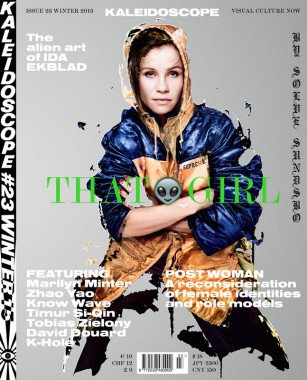
KALEIDOSCOPE Magazine 23, Winter 2015
Softcover, 272 pp., offset 4/4, 230 x 300 mm
English edition
ISSN 2038-4807
Published by KALEIDOSCOPE Press
$18.00 ·
Welcome to Kaleidoscope’s #23 (Winter 2015). Following the recent, successful redesign by Bureau Mirko Borsche, we are back with a brand new issue. The new formula is taking shape, new columnists and contributors are joining our ranks, and a lot of enthusiastic research went into curating the most compelling content out there.
In the opening section of HIGHLIGHTS, twelve profiles account for the best of the season: JASON MATTHEW LEE (by Alexander Shulan), DANIEL BAUMANN (by Aoife Rosenmeyer), MARYLIN MINTER (by Gianni Jetzer), MAGALI REUS (by Ruba Katrib), KNOW WAVE RADIO (by Alexandre Stipanovich), BEATRICE GIBSON (by George Vasey), CATHERINE AHEARN (by Tobias Czudej), K-HOLE (by Kevin McGarry), JAMIAN JULIANO-VILLANI (by Joshua Abelow), ALESSANDRO BAVA (by Francesco Garutti), ZHAO YAO (by Venus Lau), and IDEA BOOKS (by Xerxes Cook).
At a time when feminism resurges both in critical discourse and media headlines, while at the same time entering a list of words overdue to be banned, our signature MAIN THEME section is devoted to a reconsideration of female identities and role models. POST WOMAN is composed of a think tank, a think piece by Natasha Stagg and five interviews, including with Juliana Huxtable (by Andrew Durbin), Amalia Ulman (by Francesca Gavin), Judith Bernstein (by Hanne Mugaas), Massimiliano Gioni on “La Mamma” (with Pietro Rigolo), and Girls Like Us (by Felix Burrichter).
To follow, this issue’s MONO section and cover story are dedicated to Norwegian artist IDA EKBLAD. Fueled by an outright marvel for this thing called art, her work is distinguished by an extreme degree of impatience and prolificness. Her shift and turns are the result of a feverish engagement with pure materiality, synthesized with popular culture and animated by alien transformations. This definitive monographic survey comprises an essay by Peter J. Amdam, an interview by Cory Arcangel and an original portrait by Sølve Sundsbø.
Later on, the VISIONS section invites the eye to an enthralling journey across almost 100 pages of visual contributions by artists, curators and image-makers, including: TOBIAS ZIELONY, “Jenny Jenny”; MR.; “Chicago”: BARBARA CRANE and TONY LEWIS; DAVID DOUARD in Los Angeles; JONAS WOOD; “Alliantecnik,” curated by Alessio Ascari; TIMUR SI-QIN, “Premier Machinic Funerary”; and GRAHAM LITTLE.
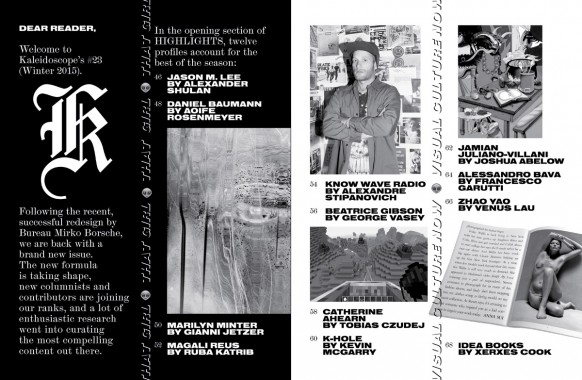
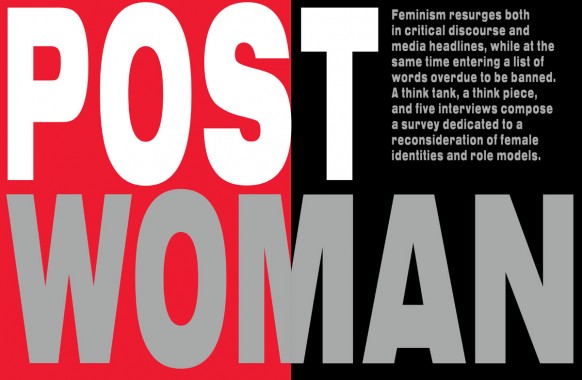
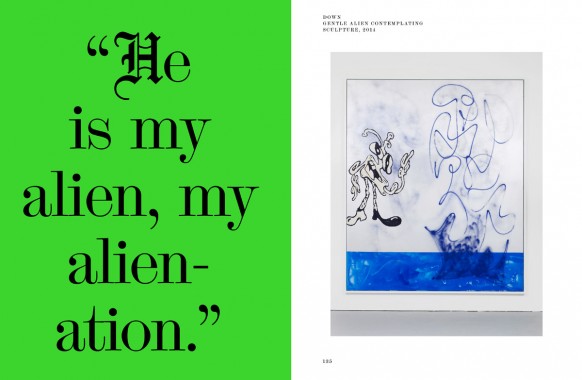
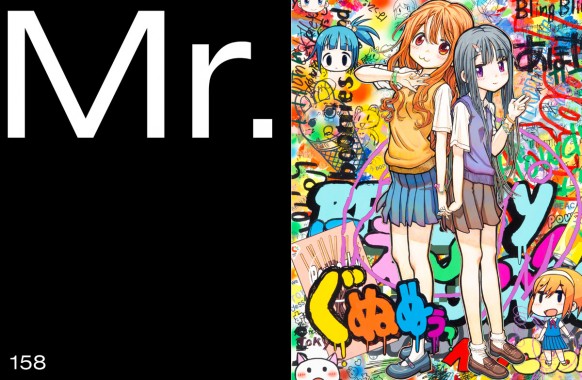
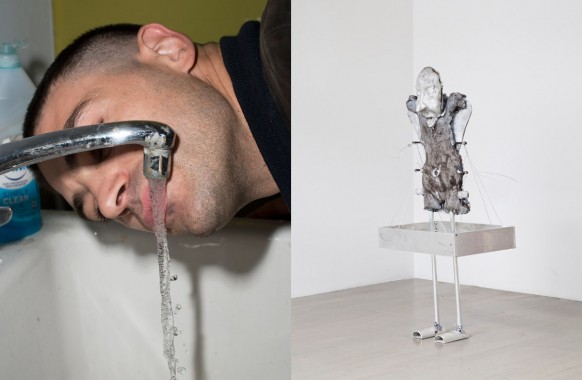
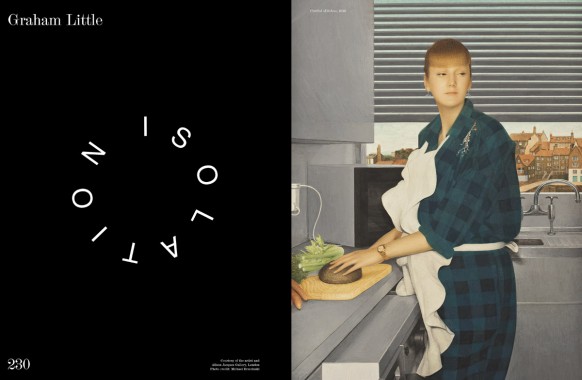
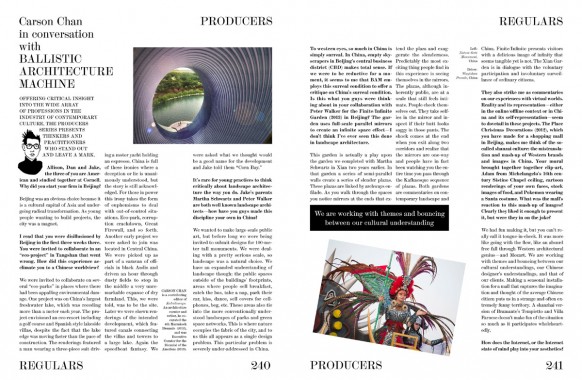
Alessandro Bava, Alessio Ascari, Alexander Shulan, Alexandre Stipanovich, Amalia Ulman, Andrew Durbin, Aoife Rosenmeyer, Art, Barbara Crane, Beatrice Gibson, Catherine Ahearn, Cory Arcangel, Culture, Daniel Baumann, David Douard, Distribution, Felix Burrichter, Francesca Gavin, Francesco Garutti, George Vasey, Gianni Jetzer, Graham Little, Hanne Mugaas, Ida Ekblad, Idea Books, Jamian Juliano-Villani, Jason Matthew Lee, Jonas Wood, Joshua Abelow, Judith Bernstein, Juliana Huxtable, KALEIDOSCOPE Press, Kevin McGarry, Magali Reus, Marilyn Minter, Massimiliano Gioni, Mirko Borsche, Natasha Stagg, Peter J Amdam, Pietro Rigolo, Ruba Katrib, Sølve Sundsbø, Timur Si-Qin, Tobias Czudeji, Tobias Zielony, Tony Lewis, Venus Lau, Xerxes Cook, Zhao Yao
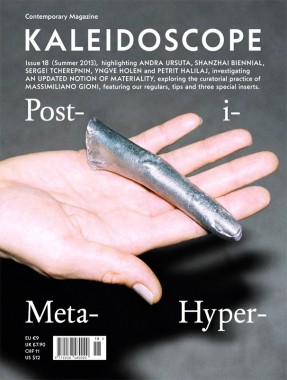
KALEIDOSCOPE Magazine 18 — Summer 2013
Softcover, 228 pp. + three special inserts, offset 4/4, 220 x 287 mm
English edition
ISSN 2038-4807
Published by KALEIDOSCOPE Press
$12.00 ·
KALEIDOSCOPE Issue 18 (summer 2013), highlighting Andra Ursuta, Shanzhai Biennial, Sergei Tcherepnin, Yngve Holen and Petrit Halilaj; investigating an updated notion of materiality; exploring the curatorial practice of Massimiliano Gioni; featuring our regulars, tips, and three special inserts.
HIGHLIGHTS
The issue’s opening section of HIGHLIGHTS features Andra Ursuta, whose practice is understood by Joanna Fiduccia as committed to annihilating sculpture’s distance from our world; the fashion-label-cum-art-project Shanzhai Biennial, whose tangible products, explains Kevin McGarry, are eclipsed by their collateral evidence; Sergei Tcherepnin, described by Lawrence Kumpf as creating a complex system of bodily configurations and social situations; Yngve Holen, whose works are read by Pablo Larios as sentient beings concerned with frustrated circulation, technological growth and associative networking; and Petrit Halilaj whose practice is framed by Elena Filipovic as rejecting pathos in favor of an intimate and critical inflection of the political.
MAIN THEME
This section, titled Post-i-Meta-Hyper-Materiality, brings together a substantial group of artists who introduce the concept of emotional and bodily alienation within the discourse dominated by the readymade, corporate art pursued by many of their digital-native peers. The elusive sculptural works of Nicholas Deshayes, Steve Bishop, Marlie Mul, Magali Reus, Ben Schumacher and Alice Channer are framed by Karen Archey as deeply engaged with materiality and production processes and imbued with bodily allusions, while also commenting on issues of abstraction, dispersion, consumption and technology. A visual essay curated by fashion futurologist Veronica So reveals how, from sculptures designed by digital simulations to edible candies formed by human body scans, the appearance of 3D printing kicks off a range of playful experiments with technology and originality. Also in this section, Alice Channer talks to Rebecca Geldard about the starting point of each work, which she describes as “a moment of material seduction”; and artists Pamela Rosenkratz and Alisa Baremboym discuss physicality versus technology and the shifting boundaries between our bodies and the external world in a cross-interview by Ruba Katrib.
MONO
Comprising an essay by Jonathan Griffin, an interview by Francesco Manacorda and a photographic portrait by Ari Marcopoulos, this issue’s MONO is devoted to the Director of the International Art Exhibition at this year’s Venice Biennale, Massimiliano Gioni. Pragmatic bordering on opportunistic throughout his adventurous career, and yet described as “a hopeless romantic” by one of his most affectionate colleagues, Gioni states that his own failure to understand is what fuels his interest in art. Generally averse to chronological or historically comprehensive presentations and departing from the tautology of the masterpiece, he is instead a proponent of Outsider and self-taught art. His exhibitions, which he defines as products of a collective intelligence, are often concerned with the position of art within our image-based society, as well as the sites of an exploration of interior worlds, dream states and psychological visions.
REGULARS
Finally, it this issue’s REGULARS, Hans Ulrich Obrist and Simon Castets interview emerging artist Amalia Ulman; Gary Carrion-Murayari stages a three-way interview with Valentin Carron and Isabelle Cornaro; Felix Burrichter meets design critic Alice Rawsthorn; Leung Chi Wo, David Clarke and Lam Tung-pang engage in a round table about the art scene in Hong Kong then and now; finally, Laura McLean-Ferristraces the legacy of folk in British contemporary art from the exhibition Black Eyes and Lemonade to the practice of Jeremy Deller.
SPECIAL INSERTS
The edition is enriched by our seasonal TIPS on following, reading, listening, stopping by, meeting and visiting; as well as by three SPECIAL INSERTS, including a selection of paintings by Benjamin Senior, photographs by Jochen Lempert and collages by Sterling Ruby.
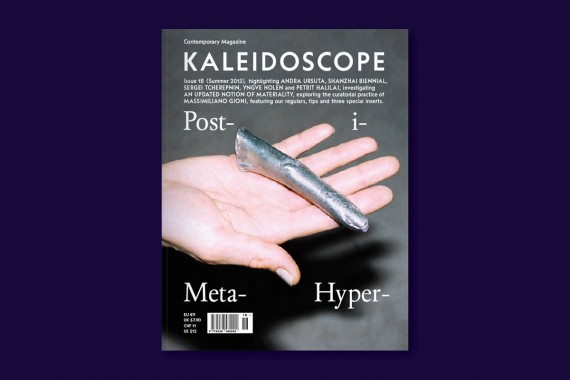
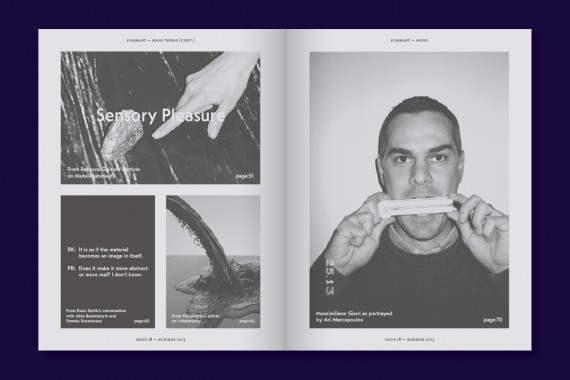
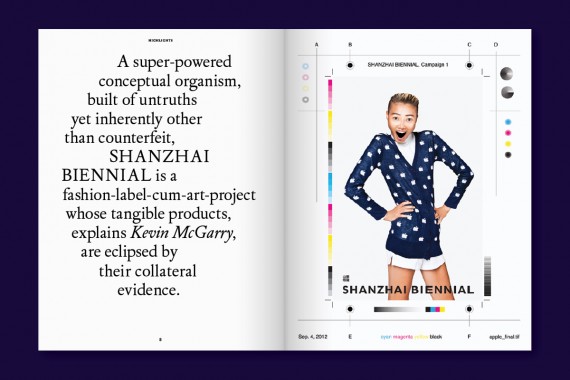
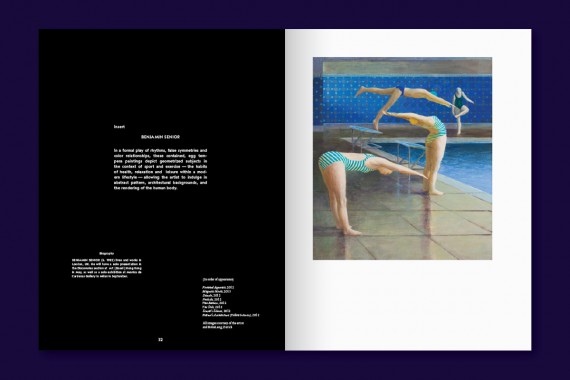
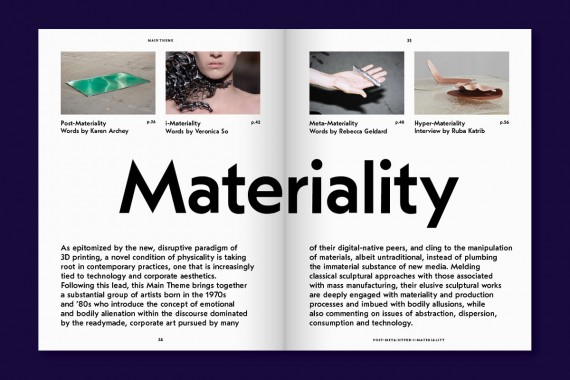
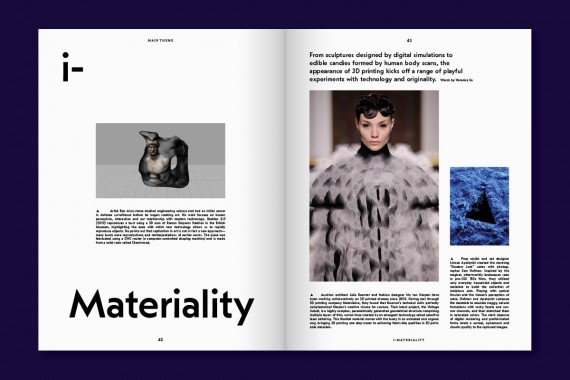
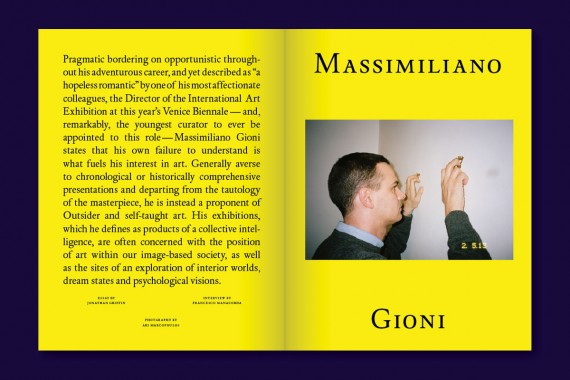
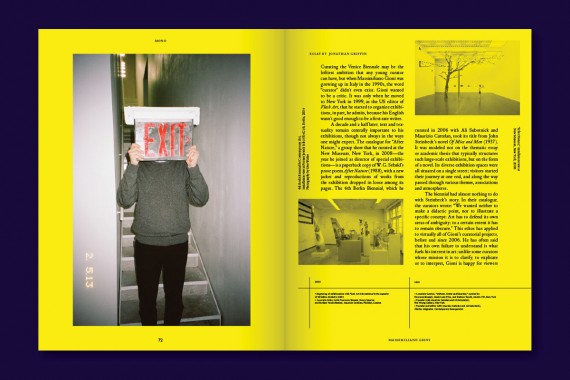
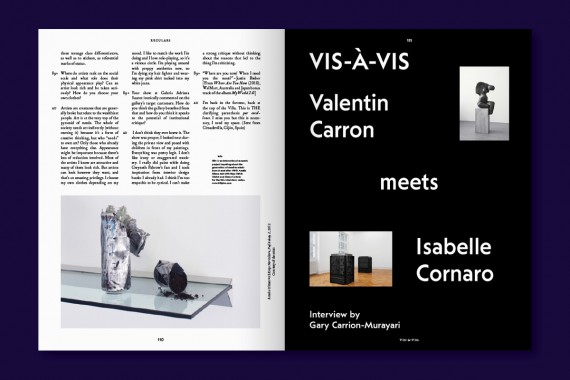
Alice Channer, Alice Rawsthorn, Alisa Baremboym, Amalia Ulman, amela Rosenkratz, Andra Ursuta, Ari Marcopoulos, Art, Ben Schumacher, Benjamin Senior, Culture, David Clarke, Distribution, Elena Filipovic, Felix Burrichter, Francesco Manacorda, Gary Carrion-Murayari, Hans Ulrich Obrist, Isabelle Cornaro, Jeremy Deller, Joanna Fiduccia, Jochen Lempert, Jonathan Griffin, KALEIDOSCOPE Press, Karen Archey, Kevin McGarry, Lam Tung-pang, Laura McLean-Ferristraces, Lawrence Kumpf, Leung Chi Wo, Magali Reus, Marlie Mul, Massimiliano Gioni, Nicholas Deshayes, Pablo Larios, Petrit Halilaj, Rebecca Geldard, Ruba Katrib, Sergei Tcherepnin, Shanzhai Biennial, Simon Castets, Sterling Ruby, Steve Bishop, Valentin Carron, Veronica So, Yngve Holen
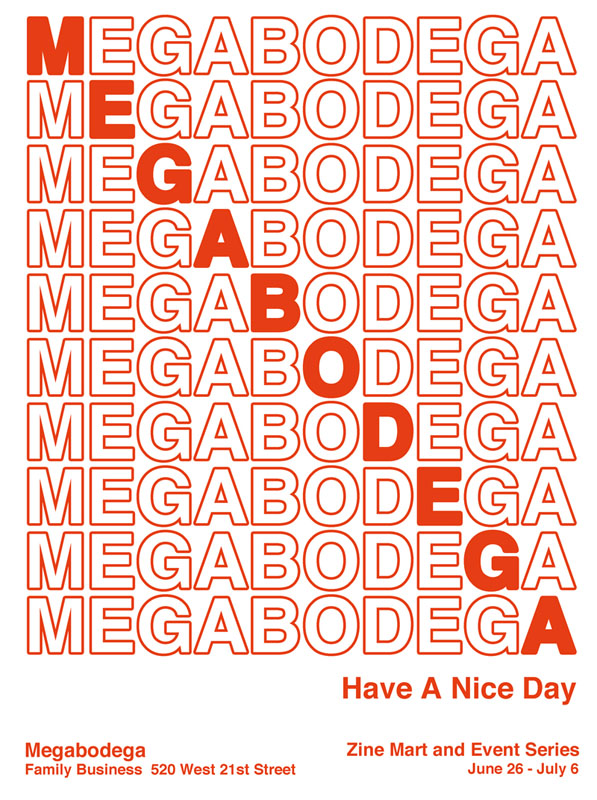
Megabodega
Zine Mart and Event Series
June 26 — July 6, 2012
Organized by Victoria Yee Howe
Family Business
520 West 21st St.
New York, NY 10012
200+ art books and magazines for sale; nightly book launches and parties; toll-free 24/7 Megabodega Hotline with new curated guest recordings daily.
Grand Opening: Tuesday, June 26, 7-10pm
Music by DJ Joro-Boro
Drinks provided by Macao Trading Co.
Family Business is the big brother of the Wrong Gallery, a minuscule space that Maurizio Cattelan, Massimiliano Gioni and Ali Subotnick ran in New York from 2002 to 2005. Just like the Wrong Gallery, Family Business is a non-profit space open to experimentation and irreverent exhibition formats.
Ali Subotnick, Art, Family Business, Massimiliano Gioni, Maurizio Cattelan, Megabodega, Victoria Yee Howe, Wrong Gallery

Maurizio Cattelan, Massimiliano Gioni, Ali Subotnick, Checkpoint Charley
Softcover, 712 pp., offset 1/1, 8.25 x 11.75 inches
Edition of 1000
ISBN 9783980426565
Published by Les Presses Du Reel
$15.00 ·
Charley is a series of publications edited by Maurizio Cattelan, Massimiliano Gioni and Ali Subotnick. A voracious creature fixated on the assimilation and consumption of visual art, the fourth issue, Checkpoint Charley, brings together images of works produced by more than 700 artists encountered by the curators of the 4th Berlin Biennial for Contemporary Art during their research. A multiform creature, Charley takes on a new theme and shape with every issue: the first featured 400 emerging artists, the second documented the 2001-2002 New York art season, and Charley 3 presented forgotten artists from the 80s and early 90s. The 4th Berlin Biennial for Contemporary Art is funded by the German Federal Cultural Foundation. Checkpoint Charley is realized with the support of the Culture 2000 program of the European Union.
Ali Subotnick, Art, Berlin Biennial, Charley, DAP, Les Presses Du Reel, Massimiliano Gioni, Maurizio Cattelan
Mono.Kultur 5, Maurizio Cattelan
Softcover, 32 pp., offset 4/1, 140 x 200 mm
Edition of 5000
ISSN 1861-7085
Published by Mono.Kultur
$8.00 ·
Cattelan, Gioni and Subotnick became known in the art world as a curating team when they founded
The Wrong Gallery in 2002. Based in New York’s art gallery district, Chelsea, the tiny non-profit art space of one square meter hosted more than 40 shows, including artists like Lawrence Weiner, Shirana Shahbazi, Tino Sehgal and Elizabeth Peyton.
The Wrong Times arose from this project: a newspaper featuring interviews with all the artists shown at
The Wrong Gallery.
Speaking of printed matters, Cattelan, Gioni and Subotnick also founded the publication series, Charley, in 2001 which deals with contemporary art in another consuming way. Based on the concept of collecting formats and contexts, the three mix up the information they find in recent publications and give way for new interpretations and coherences.
Ali Subotnick, Charley, Distribution, Kai von Rabenau, Massimiliano Gioni, Maurizio Cattelan, Mono.Kultur, The Wrong Gallery



















